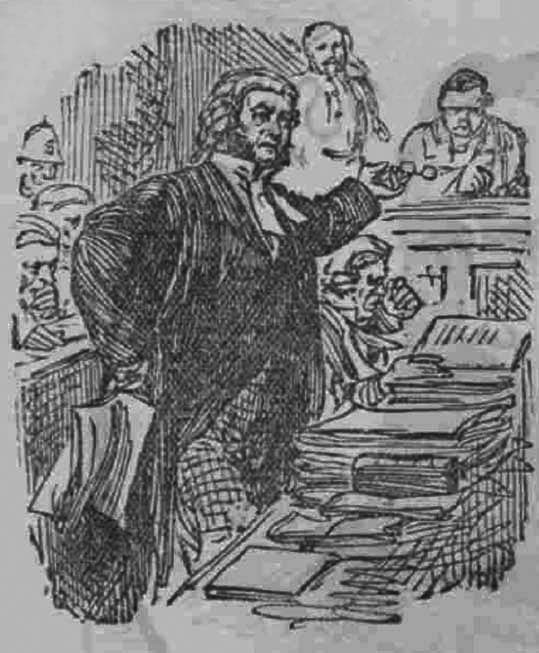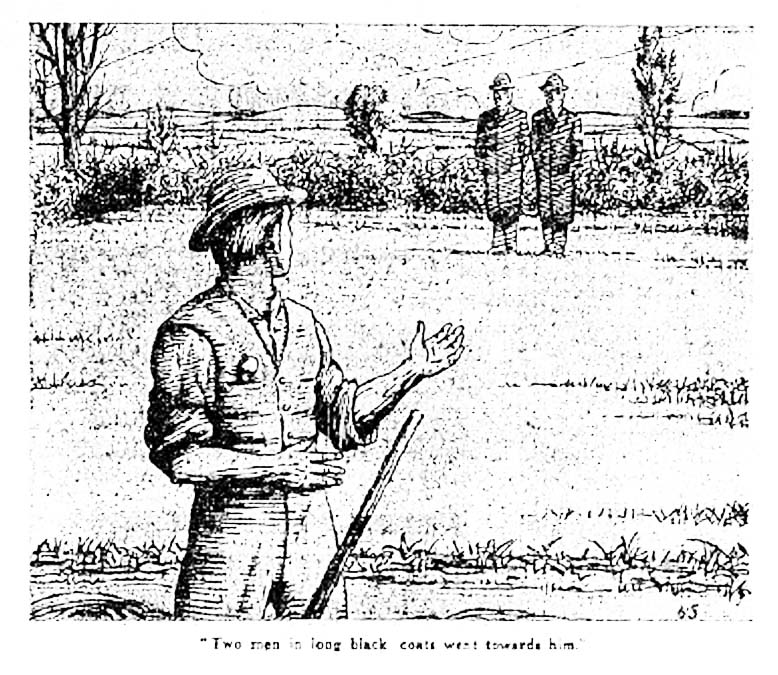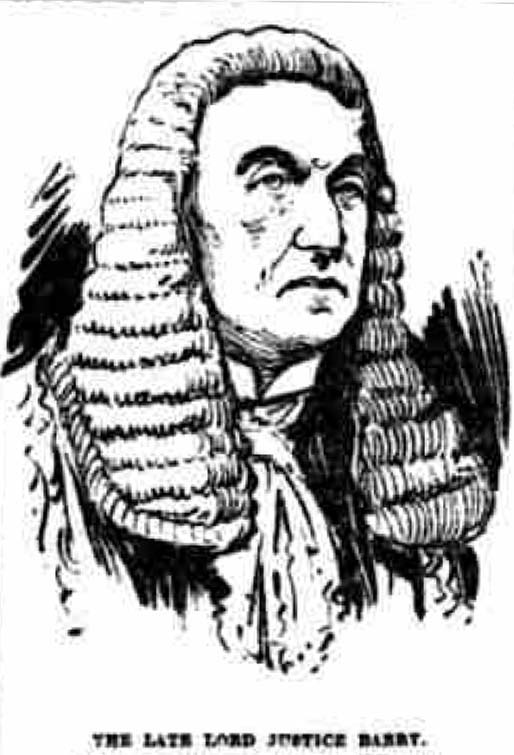‘The case should stand or fall on the evidence of Bridget Brosnan’1
On the day after Sylvester Poff and James Barrett were hanged in Tralee prison for the murder of Thomas Browne, a reporter remarked that it was ‘a matter for note’ that Mrs Brosnan, one of the chief witnesses at the trial, swore at the inquest on the day after the murder that the men she had seen going into Browne’s field were not Poff and Barrett.2
Bridget Brosnan, an old woman described by some as a ‘rogue,’ had changed her story almost two weeks after the inquest held on 3rd October 1882. She subsequently claimed that she had seen two men, not three, and that they were Poff and Barrett. On this ‘evidence,’ Poff and Barrett were arrested on the evening of the 12th October and charged.
Poff and Barrett underwent two trials in December 1882, the jury being unable to agree on the first occasion. They pleaded not guilty, and were defended by Messrs Denis Baylor Sullivan and George Lawrence. Prosecutors were Mr De Moleyns QC, Mr Peter O’Brien QC, and, at the second trial, James Murphy QC, who made a special journey from Dublin to conduct the prosecution.3

Mr De Moleyns QC, in stating the case for the Crown, discoursed on their witness Bridget Brosnan. He described her as ‘a respectable woman, who earned her livelihood by performing little jobs and to whom Browne and his family had been always kind, and she felt a corresponding feeling for them.’
He described how on the evening of the murder, 3 October 1882, Mrs Brosnan had gone out to gather a basket of rushes on the road bounding her farm. When she got up on the ditch – ‘somewhat elevated and commanding a view of the country round’– to return home, she saw Poff and Barrett approaching her, and go into a field near to the one where Thomas Browne was working.

For reasons not given, this caused Mrs Brosnan sufficient alarm to hurry to Browne’s house ‘in an alarmed and excited condition’ where she urged Mrs Browne to go into her haggard to ‘see what was going on.’ ‘Such were the material facts of the case,’ stated De Moleyns.
Bridget Brosnan was called for examination. On being sworn, Poff called out, ‘Make her kiss the book’. Mrs Brosnan proceeded to enlarge on the story as outlined above.
Johanna, Thomas Browne’s widow, was examined by Mr De Moleyns QC. She described how Mrs Brosnan had arrived at her gate ‘pale and excited’ and urged her to go into the field, ‘I thought she looked queer and frightful when she came up.’
Denis Baylor Sullivan opened the case for the prisoners. ‘Looking at the broad facts of the case,’ he stated, ‘it did at first appear somewhat startling that at 4 o’clock on that evening in October, the two prisoners, undisguised, in a locality where they were well known to everybody, should commit this dreadful assassination. Cases had occurred in which the assassins were undisguised, but that was when the assassins were strangers brought from a distance.’

Sullivan argued that there was ‘a total absence of proof’ of ill feeling between Thomas Browne and the prisoners, and no reason suggested why they should ‘imbrue their hands in the blood of their friend and neighbour.’ He reminded the jury of the fact that a large funeral had passed by Scartaglen that day, and with so many strangers around the place, thought it ‘highly improbable that any men known in the neighbourhood should run such a terrible risk.’
He said that the case for the prosecution rested exclusively upon the evidence of Bridget Brosnan, adding that her identification of the prisoners he impeached as ‘wholly unreliable’:
She came before them a tainted witness, who admittedly had on a previous occasion sworn to a deliberate falsehood. The evidence of Mrs Browne was that the assassins wore long black coats, but it would be proved that on the day in question the prisoners wore ordinary clothes, in fact ordinary grey and white frieze, worn by peasants in that part of the country.
Notwithstanding the argument of the defence, Bridget Brosnan’s testimony secured Poff and Barrett’s fate.
‘He did not believe his mother’s statement’
Bridget Brosnan did not remain in Dromultan and it was believed that she lived the remainder of her life in England. There were, however, repercussions for her family, before and in the wake of the hangings.
The day before Poff and Barrett were put to death, Timothy Sullivan, a 60-year-old farmer from Ballahantouragh, reported a case of outrage to the police. He stated that on 22 January, four armed men had tried to enter his home while he was out. They informed his daughter that they intended to shoot him for having employed Matthew Brosnan, the tailor, son of Bridget Brosnan.

They demanded the clothes made by Brosnan, the items being a coat, vest and trousers, and tore them to pieces and then they fired several shots about the house. They left, smashing two windows. ‘The motive was that Sullivan had employed Matthew Brosnan, and Brosnan was son of Bridget Brosnan who gave evidence against Poff and Barrett.’4
One week after the deaths of Poff and Barrett, a man named Brosnan was admitted to the Killarney Workhouse. He stated that no one would employ him since his mother gave evidence against Poff and Barrett for the Castleisland murder. He told the chairman of the guardians that he did not believe his mother’s statement in the case, and that ‘he would not touch a shilling of the money she had received as the reward, feeling confident he would come to a bad end if he did.’5
Almost five years later, two incidents occurred which illustrated an ongoing antagonism towards the Brosnan family. At about 5.30 pm on Monday 26 December 1887, in the village of Currans, three brothers, Maurice, Martin and John Connor, in company with Thomas Brosnan, a nephew of Bridget Brosnan, became embroiled in an argument with five men, ‘backed by a hostile crowd.’ One of the five was Andrew Barrett, brother of James Barrett.
The Connors, it appeared, had been ‘harbouring’ Thomas Brosnan. Andrew Barrett, on passing the Connors, had doffed one of them on the head with a stick and asked if he was ‘a Biddy Shea.’ The situation escalated into violence and the brothers, one of them armed with a gun, were attacked with sticks, the crowd dispersing on the arrival of the police.6
Andrew Barrett, Daniel Russell, John Leane, James Sullivan and Timothy Loughlin were subsequently charged with assault and sentenced to five months imprisonment with hard labour. 7
On the same evening, Thomas Brosnan was shot in the leg near his home at Inchincummer, near Dromultan, on suspicion of giving private information to the police. ‘Another motive assigned for the outrage, and probably the most correct, is on account of his being a relative to one of the witnesses who gave evidence against Poff and Barrett’.8
In the years that followed, the role of Bridget Brosnan in the conviction of Poff and Barrett was remembered in the songs of the people:
Poff and Barrett Ballad They went to the village of Scartaglen, Poff went for a letter and Barrett went with him, As they were going to the village they met Biddy Shea, That feeble, foul and vile old wretch, who swore their lives away.9
____________________
1 Irish Examiner, 16 December 1882. 2 Manchester Courier, 24 January 1883. Mrs Brosnan gave evidence at the inquest that she saw three men in Browne’s field that day. It was said she did not name them, but, incredibly, no depositions or notes were taken at the inquest. 3 The defence was instructed by M J Horgan, solicitor, Tralee; the prosecution by Alexander Morphy, Crown Solicitor for Kerry. 4 Considine Papers. 5 St James’s Gazette on 1 February 1883. The report gave the name as Thomas Brosnan. 6 It may be accepted that Shea was the maiden name of Bridget Brosnan. 7 The case was heard at Castleisland Petty Sessions on 23 February 1888 before resident magistrates, Cecil Roche and A J McDermott. Maurice Connor stated that they were attacked because people were ‘down’ on them for harbouring Thomas Brosnan, a nephew of Bridget Brosnan, who swore against Poff and Barrett. Report of the affair in the Kerry Sentinel, 24 February 1888. 8 Kerry Evening Post, 31 December 1887. On 3 January 1888, a group of 14 farmers from Inchincummer and district, in an effort to restore Brosnan’s good name, addressed the editor of the Kerry Weekly Reporter to the effect that Brosnan had never given private information (issue of 7 January 1888). Two men named Carroll and Healy were remanded in relation to the matter. 9 The first of five verses submitted to the Kerryman by John Somers, William Street, Clonmel in November 1955. The remaining four verses appear in the Poff and Barrett Ballad which begins, ‘Come on you lovers one and all,/And listen unto me.’ John Somers was a native of the area and recalled hearing his mother singing this ballad in his childhood. See Kerryman, 26 November 1955.


